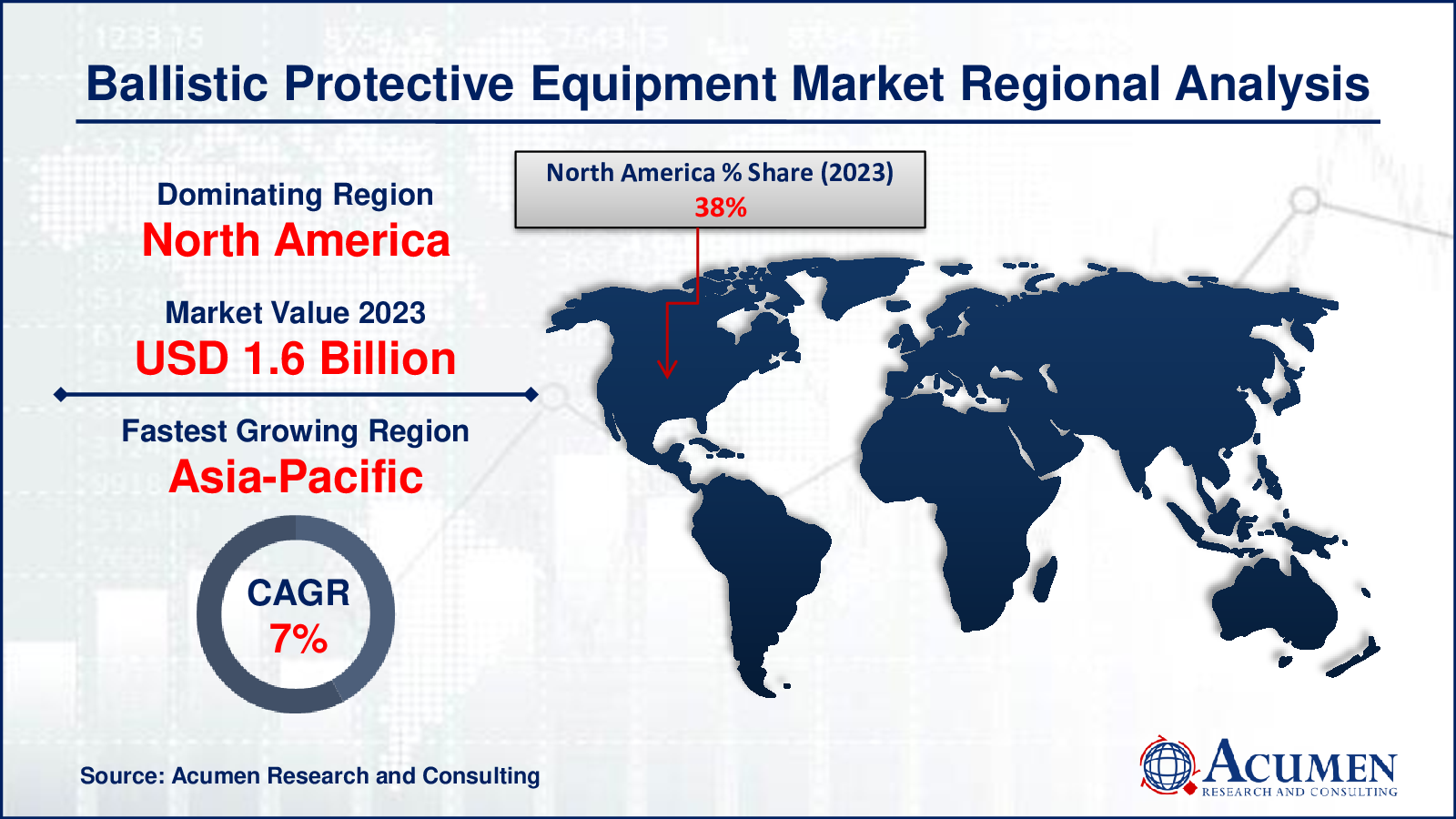Ballistic Protective Equipment Market | Acumen Research and Consulting
Ballistic Protective Equipment Market Size - Global Industry, Share, Analysis, Trends and Forecast 2024 - 2032
Published :
Report ID:
Pages :
Format : ![]()
The Ballistic Protective Equipment Market Size accounted for USD 5.1 Billion in 2023 and is projected to achieve a market size of USD 7.7 Billion by 2032 growing at a CAGR of 4.9% from 2024 to 2032.
Ballistic Protective Equipment Market Highlights
- Global ballistic protective equipment market revenue is expected to increase by USD 7.7 Billion by 2032, with a 4.9% CAGR from 2024 to 2032
- North America region led with more than 38% of ballistic protective equipment market share in 2023
- Asia-Pacific ballistic protective equipment market growth will record a CAGR of more than 5.7% from 2024 to 2032
- By raw material, the aramid segment captured more than 34% of revenue share in 2023
- By end-use, the defense segment is projected to expand at the fastest CAGR over the projected period
- Increasing geopolitical tensions and security concerns, drives the ballistic protective equipment market value

Ballistic protective equipment encompasses a range of gear designed to shield individuals from projectiles and other ballistic threats. This equipment includes bulletproof vests, helmets, shields, and plates, among other items. These products are crucial for law enforcement officers, military personnel, security professionals, and even civilians in high-risk situations. The primary purpose of ballistic protective equipment is to mitigate the impact of bullets, shrapnel, and other ballistic projectiles, thereby increasing the survivability of individuals in dangerous environments.
The market for ballistic protective equipment has witnessed significant growth in recent years, driven by escalating security concerns, increasing defense budgets, and technological advancements in protective materials. With rising geopolitical tensions and a surge in global terrorism, governments worldwide are allocating substantial funds to bolster their defense and law enforcement capabilities, thereby driving the demand for ballistic protection solutions. Moreover, advancements in materials science and manufacturing technologies have led to the development of lighter, more durable, and more effective ballistic protection gear, further fueling market growth.
Global Ballistic Protective Equipment Market Trends
Market Drivers
- Increasing geopolitical tensions and security concerns
- Technological advancements in protective materials
- Rising defense budgets globally
- Growing demand for enhanced law enforcement capabilities
- Awareness regarding personal safety among civilians
Market Restraints
- High initial investment costs
- Stringent regulatory standards and certification requirements
Market Opportunities
- Development of customizable and integrated protection solutions
- Diversification into non-traditional sectors like sports and adventure
Ballistic Protective Equipment Market Report Coverage
| Market | Ballistic Protective Equipment Market |
| Ballistic Protective Equipment Market Size 2022 | USD 5.1 Billion |
| Ballistic Protective Equipment Market Forecast 2032 | USD 7.7 Billion |
| Ballistic Protective Equipment Market CAGR During 2023 - 2032 | 4.9% |
| Ballistic Protective Equipment Market Analysis Period | 2020 - 2032 |
| Ballistic Protective Equipment Market Base Year |
2022 |
| Ballistic Protective Equipment Market Forecast Data | 2023 - 2032 |
| Segments Covered | By Raw Material, By Product, By End-use, And By Geography |
| Regional Scope | North America, Europe, Asia Pacific, Latin America, and Middle East & Africa |
| Key Companies Profiled | BAE Systems, Plc, Seyntex N.V., Rheinmetall AG, Point Blank Enterprise, Inc., Honeywell International, Inc., Morgan Advanced Materials, Craig International Ballistics, ArmorSource LLC, Tactical Assault Gear (TAG), Safe Life Defense, Hellweg International Pty. Ltd, and Survitec Group Ltd. |
| Report Coverage |
Market Trends, Drivers, Restraints, Competitive Analysis, Player Profiling, Covid-19 Analysis, Regulation Analysis |
Ballistic Protective Equipment Market Dynamics
Ballistic protective equipment refers to specialized gear designed to safeguard individuals from ballistic threats, including bullets, shrapnel, and explosive fragments. This equipment is primarily used by military personnel, law enforcement officers, security professionals, and increasingly by civilians in high-risk environments. The key components of ballistic protective equipment include bulletproof vests, helmets, shields, and plates, which are constructed using advanced materials such as aramid fibers, ceramics, and composites. These materials are chosen for their ability to absorb and disperse the energy from incoming projectiles, thereby reducing the likelihood of injury or fatality. The applications of ballistic protective equipment span a wide range of scenarios where there is a risk of ballistic threats. In military operations, soldiers rely on ballistic vests and helmets to mitigate the impact of gunfire and explosive devices on the battlefield.
The ballistic protective equipment market has experienced robust growth in recent years, driven by a combination of factors including increasing security threats, rising defense expenditures, and advancements in protective technology. With geopolitical tensions on the rise and the persistent threat of terrorism, governments worldwide are prioritizing the safety of their personnel, driving the demand for ballistic protection gear. Additionally, the expanding role of law enforcement agencies in maintaining public safety further fuels market growth, as they seek to equip their officers with the latest protective equipment to mitigate risks in high-risk situations. Furthermore, technological innovations in materials science and manufacturing processes have significantly enhanced the effectiveness and versatility of ballistic protective equipment. The development of lighter, more flexible, and higher-performing materials has not only improved wearer comfort but also increased overall protection levels.
Ballistic Protective Equipment Market Segmentation
The global ballistic protective equipment market segmentation is based on raw material, product, end-use, and geography.
Ballistic Protective Equipment Market By Raw Material
- Aramid
- Steel
- UHMWPE
- Composites
- Others
According to the ballistic protective equipment industry analysis, the aramid fiber segment accounted for the largest market share in 2023. This growth is primarily driven by the superior properties of aramid fibers such as high strength, light weight, and resistance to abrasion and impact. Aramid fibers, including renowned brands like Kevlar® and Twaron®, are widely used in the production of ballistic protective gear such as bulletproof vests, helmets, and vehicle armor due to their exceptional ballistic performance. The increasing demand for lightweight yet robust protective equipment has propelled the adoption of aramid fibers, as they offer a balance between protection and wearer comfort, crucial for prolonged use in challenging environments. Moreover, continuous advancements in aramid fiber technology have further augmented their appeal in the ballistic protective equipment market. Manufacturers are constantly innovating to enhance the performance characteristics of aramid fibers, including improved ballistic resistance, durability, and flexibility.
Ballistic Protective Equipment Market By Product
- Head Protection
- Hard Armor
- Soft Armor
In terms of products, the soft armor segment is expected to witness significant growth in the coming years. This growth is primarily due to advancements in material technology and an increasing focus on lightweight, flexible protection solutions. Soft armor, typically made from aramid fibers or ultra-high-molecular-weight polyethylene (UHMWPE), offers exceptional ballistic resistance while providing wearers with greater mobility and comfort compared to traditional rigid armor solutions. This flexibility and comfort are particularly crucial for law enforcement officers, military personnel, and security professionals who require prolonged wear during their duties. Furthermore, the growing emphasis on personal safety and the rising incidence of armed violence have fueled the demand for soft armor solutions across various end-user segments.
Ballistic Protective Equipment Market By End-use
- Defense
- Commercial
- Law Enforcement & Security
According to the ballistic protective equipment market forecast, the defense segment is expected to witness significant growth in the coming years. This growth is driven by increasing defense budgets worldwide and the evolving nature of modern warfare. As nations prioritize the safety and effectiveness of their military personnel, there has been a significant uptick in the procurement of advanced ballistic protection gear. Military forces are investing in state-of-the-art equipment, including body armor, helmets, and vehicle armor, to enhance the survivability and operational capability of their troops in combat situations. Moreover, the emergence of asymmetric threats, such as insurgencies and terrorist organizations, has further accelerated the demand for ballistic protective equipment in the defense sector. Military operations in urban environments and unconventional warfare scenarios necessitate agile and adaptable protection solutions that can withstand a range of ballistic threats while allowing for mobility and flexibility.
Ballistic Protective Equipment Market Regional Outlook
North America
- U.S.
- Canada
Europe
- U.K.
- Germany
- France
- Spain
- Rest of Europe
Asia-Pacific
- India
- Japan
- China
- Australia
- South Korea
- Rest of Asia-Pacific
Latin America
- Brazil
- Mexico
- Rest of Latin America
The Middle East & Africa
- South Africa
- GCC Countries
- Rest of the Middle East & Africa (ME&A)

Ballistic Protective Equipment Market Regional Analysis
North America stands out as a dominant and rapidly growing region in the ballistic protective equipment market due to several key factors. The region boasts a significant defense budget, with the United States being the world's largest spender on defense. This substantial investment in military capabilities drives demand for advanced ballistic protection gear for military personnel, including body armor, helmets, and vehicle armor. Moreover, North American law enforcement agencies also prioritize officer safety, leading to a steady demand for ballistic protective equipment for use in various operational scenarios. Furthermore, North America benefits from a robust industrial base and a highly developed research and development ecosystem. The presence of leading manufacturers and innovators in the region enables the continuous advancement of ballistic protection technologies, including the development of lighter, more durable materials and the integration of smart features for enhanced functionality. Additionally, stringent safety regulations and standards in North America contribute to the high quality and reliability of ballistic protective equipment produced in the region, enhancing its competitiveness in both domestic and international markets
Ballistic Protective Equipment Market Player
Some of the top ballistic protective equipment market companies offered in the professional report include BAE Systems, Plc, Seyntex N.V., Rheinmetall AG, Point Blank Enterprise, Inc., Honeywell International, Inc., Morgan Advanced Materials, Craig International Ballistics, ArmorSource LLC, Tactical Assault Gear (TAG), Safe Life Defense, Hellweg International Pty. Ltd, and Survitec Group Ltd.
Frequently Asked Questions
What was the market size of the global ballistic protective equipment in 2023?
The market size of ballistic protective equipment was USD 5.1 Billion in 2023.
What is the CAGR of the global ballistic protective equipment market from 2024 to 2032?
The CAGR of ballistic protective equipment is 4.9% during the analysis period of 2024 to 2032.
Which are the key players in the ballistic protective equipment market?
The key players operating in the global market are including BAE Systems, Plc, Seyntex N.V., Rheinmetall AG, Point Blank Enterprise, Inc., Honeywell International, Inc., Morgan Advanced Materials, Craig International Ballistics, ArmorSource LLC, Tactical Assault Gear (TAG), Safe Life Defense, Hellweg International Pty. Ltd, and Survitec Group Ltd.
Which region dominated the global ballistic protective equipment market share?
North America held the dominating position in ballistic protective equipment industry during the analysis period of 2024 to 2032.
Which region registered fastest CAGR from 2024 to 2032?
Asia-Pacific region exhibited fastest growing CAGR for market of ballistic protective equipment during the analysis period of 2024 to 2032.
What are the current trends and dynamics in the global ballistic protective equipment industry?
The current trends and dynamics in the ballistic protective equipment industry include increasing geopolitical tensions and security concerns, technological advancements in protective materials, and rising defense budgets globally.
Which product held the maximum share in 2023?
The soft armor product held the maximum share of the ballistic protective equipment industry.


